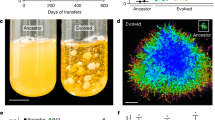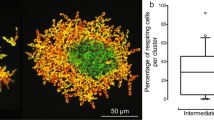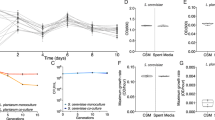Abstract
The evolution of multicellular life spurred evolutionary radiations, fundamentally changing many of Earth’s ecosystems. Yet little is known about how early steps in the evolution of multicellularity affect eco-evolutionary dynamics. Through long-term experimental evolution, we observed niche partitioning and the adaptive divergence of two specialized lineages from a single multicellular ancestor. Over 715 daily transfers, snowflake yeast were subjected to selection for rapid growth, followed by selection favouring larger group size. Small and large cluster-forming lineages evolved from a monomorphic ancestor, coexisting for over ~4,300 generations, specializing on divergent aspects of a trade-off between growth rate and survival. Through modelling and experimentation, we demonstrate that coexistence is maintained by a trade-off between organismal size and competitiveness for dissolved oxygen. Taken together, this work shows how the evolution of a new level of biological individuality can rapidly drive adaptive diversification and the expansion of a nascent multicellular niche, one of the most historically impactful emergent properties of this evolutionary transition.
This is a preview of subscription content, access via your institution
Access options
Access Nature and 54 other Nature Portfolio journals
Get Nature+, our best-value online-access subscription
$29.99 / 30 days
cancel any time
Subscribe to this journal
Receive 12 digital issues and online access to articles
$119.00 per year
only $9.92 per issue
Buy this article
- Purchase on Springer Link
- Instant access to full article PDF
Prices may be subject to local taxes which are calculated during checkout





Similar content being viewed by others
Data availability
Underlying data used to generate figures and raw data are available on GitHub (https://github.com/Ratcliff-Lab/coexistence-paper.git). Raw Illumina sequencing reads are available at the NIH Sequence Read Archive under accession number PRJNA1064559. Source data are provided with this paper.
Code availability
Codes used to generate the main figures are available on GitHub (https://github.com/Ratcliff-Lab/coexistence-paper.git).
References
Maloof, A. C. et al. The earliest Cambrian record of animals and ocean geochemical change. GSA Bull. 122, 1731–1774 (2010).
McMahon, S. & Parnell, J. The deep history of Earth’s biomass. J. Geol. Soc. 175, 716–720 (2018).
Delwiche, C. F. & Cooper, E. D. The evolutionary origin of a terrestrial flora. Curr. Biol. 25, R899–R910 (2015).
Odling-Smee, F. J., Laland, K. N. & Feldman, M. W. Niche construction. Am. Nat. 147, 641–648 (1996).
Boyce, C. K. The evolutionary history of roots and leaves. in Vascular Transport in Plants (eds Holbrook, N. M. & Zwieniecki, M. A.) 479–499 (Elsevier, 2005).
Kenrick, P. & Strullu-Derrien, C. The origin and early evolution of roots. Plant Physiol. 166, 570–580 (2014).
Rose, C. J. & Hammerschmidt, K. What do we mean by multicellularity? The evolutionary transitions framework provides answers. Front. Ecol. Evol. 9, 730714 (2021).
Bonner, J. T. The Evolution of Complexity by Means of Natural Selection (Princeton Univ. Press, 1988).
Bourrat, P., Doulcier, G., Rose, C. J., Rainey, P. B. & Hammerschmidt, K. Tradeoff breaking as a model of evolutionary transitions in individuality and limits of the fitness-decoupling metaphor. ELife 11, e73715 (2022).
Ratcliff, W. C., Denison, R. F., Borrello, M. & Travisano, M. Experimental evolution of multicellularity. Proc. Natl Acad. Sci. USA 109, 1595–1600 (2012).
Bozdag, G. O., Libby, E., Pineau, R., Reinhard, C. T. & Ratcliff, W. C. Oxygen suppression of macroscopic multicellularity. Nat. Commun. 12, 2838 (2021).
Bozdag, G. O. et al. De novo evolution of macroscopic multicellularity. Nature 617, 747–754 (2023).
Pentz, J. T., Taylor, B. P. & Ratcliff, W. C. Apoptosis in snowflake yeast: novel trait, or side effect of toxic waste? J. R. Soc. Interface 13, 20160121 (2016).
Jacobeen, S. et al. Cellular packing, mechanical stress and the evolution of multicellularity. Nat. Phys. 14, 286–290 (2018).
Zamani-Dahaj, S. A. et al. Spontaneous emergence of multicellular heritability. Genes 14, 1635 (2023).
Tong, K., Bozdag, G. O. & Ratcliff, W. C. Selective drivers of simple multicellularity. Curr. Opin. Microbiol. 67, 102141 (2022).
Knoll, A. H. The multiple origins of complex multicellularity. Annu. Rev. Earth Planet. Sci. 39, 217–239 (2011).
Herron, M. D. et al. De novo origins of multicellularity in response to predation. Sci. Rep. 9, 2328 (2019).
Kapsetaki, S. E. & West, S. A. The costs and benefits of multicellular group formation in algae. Evolution 73, 1296–1308 (2019).
Rebolleda-Gómez, M., Ratcliff, W. C., Fankhauser, J. & Travisano, M. Evolution of simple multicellularity increases environmental complexity. Preprint at bioRxiv https://doi.org/10.1101/067991 (2016).
Ratcliff, W. C., Fankhauser, J. D., Rogers, D. W., Greig, D. & Travisano, M. Origins of multicellular evolvability in snowflake yeast. Nat. Commun. 6, 6102 (2015).
Levin, B. Frequency-dependent selection in bacterial populations. Phil. Trans. R. Soc. Lond. B 319, 459–472 (1988).
Heino, M., Metz, J. A. & Kaitala, V. The enigma of frequency-dependent selection. Trends Ecol. Evol. 13, 367–370 (1998).
Chevin, L.-M. On measuring selection in experimental evolution. Biol. Lett. 7, 210–213 (2011).
Schirrmeister, B. E., de Vos, J. M., Antonelli, A. & Bagheri, H. C. Evolution of multicellularity coincided with increased diversification of cyanobacteria and the great oxidation event. Proc. Natl Acad. Sci. USA 110, 1791–1796 (2013).
Szathmáry, E. & Smith, J. M. The major evolutionary transitions. Nature 374, 227–232 (1995).
Szathmáry, E. Toward major evolutionary transitions theory 2.0. Proc. Natl Acad. Sci. USA 112, 10104–10111 (2015).
Simpson, G. G.Tempo and Mode in Evolution (Columbia Univ. Press, 1984).
Yoder, J. et al. Ecological opportunity and the origin of adaptive radiations. J. Evol. Biol. 23, 1581–1596 (2010).
Le Hir, G. et al. The climate change caused by the land plant invasion in the Devonian. Earth Planet. Sci. Lett. 310, 203–212 (2011).
Dahl, T. W. & Arens, S. K. The impacts of land plant evolution on Earth’s climate and oxygenation state–an interdisciplinary review. Chem. Geol. 547, 119665 (2020).
Erwin, D. H. & Tweedt, S. Ecological drivers of the Ediacaran-Cambrian diversification of Metazoa. Evol. Ecol. 26, 417–433 (2012).
Warren, L. et al. Origin and impact of the oldest metazoan bioclastic sediments. Geology 41, 507–510 (2013).
McIlroy, D. & Logan, G. A. The impact of bioturbation on infaunal ecology and evolution during the Proterozoic-Cambrian transition. Palaios 14, 58–72 (1999).
Billingham, J. (ed.) Life in the Universe NASA Conference Pulication 2156 (NASA, 1981).
Kassen, R. The experimental evolution of specialists, generalists, and the maintenance of diversity. J. Evol. Biol. 15, 173–190 (2002).
Doebeli, M., Ispolatov, Y. & Simon, B. Towards a mechanistic foundation of evolutionary theory. Elife 6, e23804 (2017).
Roff, D. Evolution of Life Histories: Theory and Analysis (Springer, 1993).
Stearns, S. C. Trade-offs in life-history evolution. Funct. Ecol. 3, 259–268 (1989).
Sibly, R. M. in Encyclopedia of Evolution (ed. Pagel, M.) 623–627 (Oxford Univ. Press, 2002).
Rainey, P. B. & Travisano, M. Adaptive radiation in a heterogeneous environment. Nature 394, 69–72 (1998).
Koza, A., Moshynets, O., Otten, W. & Spiers, A. J. Environmental modification and niche construction: developing O2 gradients drive the evolution of the wrinkly spreader. ISME J. 5, 665–673 (2011).
Kinnersley, M. et al. Ex uno plures: clonal reinforcement drives evolution of a simple microbial community. PLoS Genet. 10, e1004430 (2014).
Frenkel, E. M. et al. Crowded growth leads to the spontaneous evolution of semistable coexistence in laboratory yeast populations. Proc. Natl Acad. Sci. USA 112, 11306–11311 (2015).
Mizuuchi, R., Furubayashi, T. & Ichihashi, N. Evolutionary transition from a single RNA replicator to a multiple replicator network. Nat. Commun. 13, 1460 (2022).
Mahler, D. L., Revell, L. J., Glor, R. E. & Losos, J. B. Ecological opportunity and the rate of morphological evolution in the diversification of Greater Antillean anoles. Evolution 64, 2731–2745 (2010).
Wellborn, G. A. & Langerhans, R. B. Ecological opportunity and the adaptive diversification of lineages. Ecol. Evol. 5, 176–195 (2015).
Dobson, A., Tilman, D. & Holt, R. D. Unsolved Problems in Ecology (Princeton Univ. Press, 2020).
Godfray, H. C. J. & May, R. M. Open questions: are the dynamics of ecological communities predictable? BMC Biol. 12, 22 (2014).
Godfrey-Smith, P. in From Groups to Individuals: Evolution and Emerging Individuality (eds Bouchard, F. & Huneman, P.) Ch. 1 (MIT Press, 2013).
Bonner, J. T. The origins of multicellularity. Integr. Biol. 1, 27–36 (1998).
Bonner, J. T. Why Size Matters: From Bacteria to Blue Whales (Princeton Univ. Press, 2007).
Velicer, G. J. & Yu, Y.-tN. Evolution of novel cooperative swarming in the bacterium Myxococcus xanthus. Nature 425, 75–78 (2003).
Jeon, K. W. Development of cellular dependence on infective organisms: micrurgical studies in amoebas. Science 176, 1122–1123 (1972).
Barber, J. N. et al. The evolution of coexistence from competition in experimental co-cultures of Escherichia coli and Saccharomyces cerevisiae. ISME J. 15, 746–761 (2021).
Blount, Z. D., Borland, C. Z. & Lenski, R. E. Historical contingency and the evolution of a key innovation in an experimental population of Escherichia coli. Proc. Natl Acad. Sci. USA 105, 7899–7906 (2008).
Mukherjee, A. et al. Coexisting ecotypes in long-term evolution emerged from interacting trade-offs. Nat. Commun. 14, 3805 (2023).
Velicer, G. J., Kroos, L. & Lenski, R. E. Developmental cheating in the social bacterium Myxococcus xanthus. Nature 404, 598–601 (2000).
Hart, S. F. M., Pineda, J. M. B., Chen, C.-C., Green, R. & Shou, W. Disentangling strictly self-serving mutations from win-win mutations in a mutualistic microbial community. Elife 8, e44812 (2019).
Harcombe, W. Novel cooperation experimentally evolved between species. Evolution 64, 2166–2172 (2010).
Ratcliff, W. C. et al. Experimental evolution of an alternating uni- and multicellular life cycle in Chlamydomonas reinhardtii. Nat. Commun. 4, 2742 (2013).
Gietz, R. D. & Schiestl, R. H. Quick and easy yeast transformation using the LiAc/SS carrier DNA/PEG method. Nat. Protoc. 2, 35–37 (2007).
Chen, S., Zhou, Y., Chen, Y. & Gu, J. fastp: an ultra-fast all-in-one FASTQ preprocessor. Bioinformatics 34, i884–i890 (2018).
Li, H. Aligning sequence reads, clone sequences and assembly contigs with bwa-mem. Preprint at https://doi.org/10.48550/arXiv.1303.3997 (2013).
Li, H. et al. The sequence alignment/map format and samtools. Bioinformatics 25, 2078–2079 (2009).
Barnett, D. W., Garrison, E. K., Quinlan, A. R., Strömberg, M. P. & Marth, G. T. Bamtools: a C++ API and toolkit for analyzing and managing BAM files. Bioinformatics 27, 1691–1692 (2011).
Van der Auwera, G. A. et al. From FastQ data to high-confidence variant calls: the genome analysis toolkit best practices pipeline. Curr. Protoc. Bioinformatics 43, 11.10.1–11.10.33 (2013).
Danecek, P. et al. The variant call format and vcftools. Bioinformatics 27, 2156–2158 (2011).
Robinson, J. T., Thorvaldsdóttir, H., Turner, D. & Mesirov, J. P. igv.js: an embeddable Javascript implementation of the Integrative Genomics Viewer (IGV). Bioinformatics 39, btac830 (2023).
Jukes, T. H. & Cantor, C. R. et al. in Mammalian Protein Metabolism (ed. Munro, H. N.) 21–132 (Academic Press, 1969).
Bouckaert, R. et al. BEAST 2: a software platform for Bayesian evolutionary analysis. PLoS Comput. Biol. 10, e1003537 (2014).
Acknowledgements
We thank the members of the Ratcliff lab for their input on the project, as well as the GT QBioS Graduate Program for its support (this paper would not exist without the incredible work of program coordinator L. Redding). This work was supported by grants from the NIH (Grant No. 5R35GM138030) and the NSF Division of Environmental Biology (Grant No. DEB-1845363) to W.C.R. P.J.Y. acknowledges funding from the NIH National Institute of General Medical Sciences (Grant No. 1R35GM138354-01).
Author information
Authors and Affiliations
Contributions
R.M.P., W.C.R., E.L. and G.O.B. designed the study and wrote the paper. R.M.P. and D.T.L. performed the experiments and analysed the data. G.O.B. performed the evolution experiment. E.L., R.M.P., D.D., P.B., P.J.Y., T.C.D., W.C.R. and J.S.W. developed and analysed the model. All authors contributed to editing the paper.
Corresponding authors
Ethics declarations
Competing interests
The authors declare no competing interests.
Peer review
Peer review information
Nature Ecology & Evolution thanks Sean Buskirk, Milo Johnson and the other, anonymous, reviewer(s) for their contribution to the peer review of this work.
Additional information
Publisher’s note Springer Nature remains neutral with regard to jurisdictional claims in published maps and institutional affiliations.
Extended data
Extended Data Fig. 1 Size distributions of isolates from the ancestor and the five lines subject to long term evolution, after 715 days of serial transfers ( ~ 4,300 generations).
We observe the emergence of phenotypic diversity in lines PO-3, PO-4 and PO-5. The different colors denote different isolates.
Extended Data Fig. 2 Standing diversity within population PO-4.
(A) Whole population size distribution (n > 1000) and b picture of PO-4 after 715 days of serial transfers ( ~ 4300 generations). Large-sized snowflake yeast were present at a mean frequency of 9.4% in the whole t715 population (Extended Data Fig. 4). This image is representative of the whole population.
Extended Data Fig. 3 Phylogeny of independently evolved line PO-3, showing deep divergence between Small and Large isolates.
They do not share any mutations, indicating that the last common ancestor of these lineages was the genotype used to found the experiment, and these lineages have been coexisting for the full duration of the experiment. Here, the color represents the phenotype (Small or Large), and numbers PO-3-1, PO-3-2, and PO-3-3 represent three isolates of Small and Large yeast sampled from line PO-3.
Extended Data Fig. 4 Coexistence over time.
To examine the stability of coexistence throughout the experiment, we measured the frequency and group size at time 200, 400 and 600. We estimated the frequency of large and small phenotypes by segmenting microscopy images at these timepoints. (A) The large phenotype declined in frequency as a function of time, at approximately 1.3% per 100 transfers (y = 11.96 -.013x, P = 0.00017, linear regression. Adjusted R2 = 0.86). Bars represent one standard deviation. (B) There were no obvious differences in the size of large and small phenotypes over time, though the main effects of time and phenotype were highly significant (F1, 18173 = 226.8 and 6989.5, respectively, P < 10−15 for each, two-way ANOVA), as was the interaction between phenotype and time (F1,18173 = 23.7, P < 10−5). Bars represent one standard deviation. (C) Snapshots of PO-4 populations for each time point measured.
Extended Data Fig. 5 Frequency dependence and specialization along a growth-survival trade-off.
To test for frequency dependence in the experiment, we initiated one round of growth and one round of settling selection starting from a wide range of initial 10 frequencies (from 1% to 99%). The proportion of Large clusters after 24 hours of growth (A), but not after settling (B), is frequency dependent. Linear regression fit for growth: β = -1.5, R2 = 0.6, P = 0.0002 ; Linear regression fit for selection: β = -1.2, R2 = 0.04, P = 0.2.
Supplementary information
Supplementary Information
Supplementary Figs. 1 and 2 with model derivations.
Supplementary Data 1
List of mutations found in the Small and Large isolates from PO-3 and PO-4 populations.
Source data
Source Data Figs. 1, 2 and 5, and Extended Data Figs. 1, 2, 4 and 5
Excel file with 12 tabs.
Rights and permissions
Springer Nature or its licensor (e.g. a society or other partner) holds exclusive rights to this article under a publishing agreement with the author(s) or other rightsholder(s); author self-archiving of the accepted manuscript version of this article is solely governed by the terms of such publishing agreement and applicable law.
About this article
Cite this article
Pineau, R.M., Libby, E., Demory, D. et al. Emergence and maintenance of stable coexistence during a long-term multicellular evolution experiment. Nat Ecol Evol (2024). https://doi.org/10.1038/s41559-024-02367-y
Received:
Accepted:
Published:
DOI: https://doi.org/10.1038/s41559-024-02367-y



